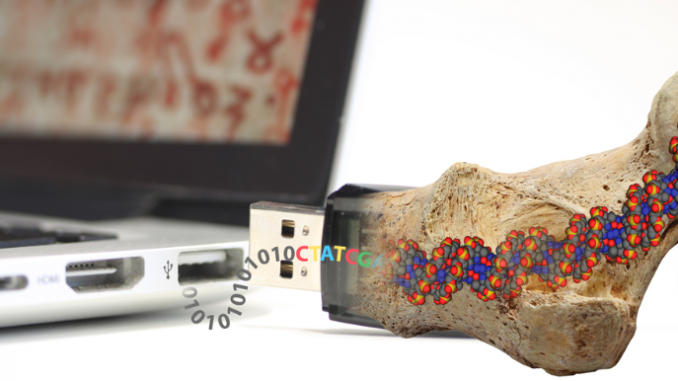
Scientists in Switzerland have developed a method to “write” huge amounts of DNA information and a new way to store it.
According to Reuters, the researchers plan to store the DNA information in “synthetic fossils” which could potentially survive thousands of years:
In past centuries, books and scrolls preserved the knowledge of our ancestors, even though they were prone to damage and disintegration. In the digital era, most of humanity’s collective knowledge is stored on servers and hard drives. But these have a limited lifespan and need constant maintenance.

BYPASS THE CENSORS
Sign up to get unfiltered news delivered straight to your inbox.
You can unsubscribe any time. By subscribing you agree to our Terms of Use
Scientists from ETH Zurich have taken inspiration from the natural world in a bid to devise a storage medium that could last for potentially thousands of years. They say that genetic material found in fossils hundreds of thousands of years old can be isolated and analyzed as it has been protected from environmental stresses.
“(The) fascination of having this very, extremely old information – a hundred thousand years, older than anything else humanity knows – in DNA. So it kind of tells us that it’s a really stable material which can endure nature or the environment for a very long time,” said Dr. Robert Grass, a senior scientist at ETH Zurich’s Department of Chemistry and Applied Biosciences.
In order to protect information-bearing DNA they encapsulated it in a synthetic ‘fossil’ shell made from a microscopic silica glass particle with diameter of roughly 150 nanometers.
“We looked at ways of stabilizing DNA, and we developed a method of encapsulating DNA into small glass particles. And we’ve shown that in these particles traces are more stable, these DNA traces are more stable than they are otherwise in the environment,” added Grass.
The researchers say that encapsulation in silica is roughly comparable to that of fossilized bones. The long-term stability of the DNA can be estimated by comparisons to other DNA storage facilities, such as Norway’s Svalbard Global Seed Vault, where genetic material is stored at minus 18 degrees Celsius and can survive for more than a million years.
To demonstrate the technology, the researchers encoded in DNA “The Methods of Mechanical Theorems” written by ancient Greek scientist Archimedes at least two thousand years ago. Grass explained how his team devised a method for translating the written word into DNA. “We decide how a letter is translated to a sequence of, let’s say, nucleotides – so the building blocks of DNA. And so we then generate an enormous file that instead of letters and spaces and numbers, it’s just a sequence of A, C, T and G,” he said. “This file we send to a company and that company synthesizes that DNA according to our file we sent them. So they then synthesize DNA sequences with exactly the sequence of the nucleotides that we predefined.”
They then simulated the degradation of the DNA over a long period of time by storing it at a temperature between 60 and 70 degrees Celsius for up to a month, replicating the chemical degradation that takes place over hundreds of years within a few weeks. The glass shells turned out to be particularly robust and, through the use of a fluoride solution, the DNA could be easily separated from the glass so the information can be read.
Successfully decoding the DNA-encoded information required a built in fail-safe mechanism. New algorithms designed by Reinhard Heckel from ETH Zurich’s Communication Technology Laboratory added extra layers of information to the actual data so that it was still accurate and error-free even if one part of the data got lost or shifted.
Despite proving the technology at their lab in Zurich, the team concedes that viable DNA data storage will need significant investment to become a reality. While the hardware to decode the DNA has become cheaper, the cost of actually manufacturing DNA with the information encoded inside is still very expensive. Grass said it will take investment from governments and large corporations to make it possible.
But he added that the prospect of storing mankind’s collective knowledge in a sprinkling of synthetic DNA could eventually mean information security for future generations.
“If you, for example, think of a tablespoon filled with DNA; that would include all of the information on Facebook and Wikipedia and Twitter – and all that just in that small heap of DNA. Whereas nowadays you need enormous server farms and cooling and maintenance because the current methods decay over time,” said Grass.
“In that tablespoon you would have everything very stable in a very small space with a guaranteed stability for a very long time.”
Latest posts by Royce Christyn (see all)
- Irish Slaves – What The History Books Will Never Tell You - November 1, 2017
- Government Op Who Predicted Super Bowl Score Warns Of Nuclear War - February 18, 2017
- Video: Why Voting Doesn’t Change Anything & Democracy Is A Lie - May 7, 2016


Be the first to comment